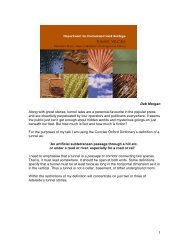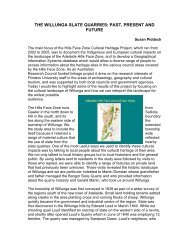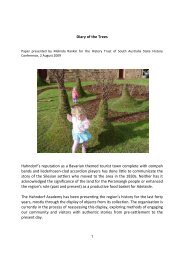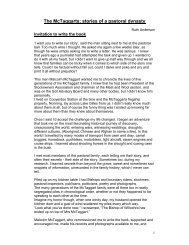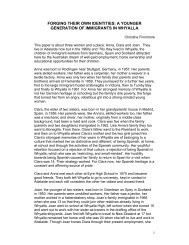Southward Bound Information - History SA
Southward Bound Information - History SA
Southward Bound Information - History SA
You also want an ePaper? Increase the reach of your titles
YUMPU automatically turns print PDFs into web optimized ePapers that Google loves.
The spaces for the single men and single women were separated by the married<br />
quarters.<br />
Tables ran the entire length of the ship, with fixed seats on each side. Water<br />
closets were provided for females and children, men were expected to go on deck.<br />
(illustration)<br />
CONDITIONS<br />
THE INFORMATION CONTAINED WITHIN THIS SECTION RELATES MAINLY<br />
TO THE STEERAGE ACCOMMODATION ON MIGRANT SHIPS..<br />
SPACE:<br />
Imagine the scene below decks - great beams, ringbolts and the general bulk of<br />
the ship, emigrant berths and chests, bundles and barrels, heaps of miscellaneous<br />
baggage and the few square feet of space which was to be the emigrants home<br />
for months.<br />
In an attempt to see that conditions were bearable, British Parliament passed<br />
several acts limiting the number of people who could be carried on each ship,<br />
setting out how much space each immigrant should be allowed and stating the<br />
amount of provisions each ship should carry. These acts stipulated how much<br />
space each migrant should have below deck, but there was no mention of deck<br />
space for exercise and relaxation.<br />
Deck space for steerage passengers was often limited by:<br />
(a) masses of rigging<br />
(b) extra lifeboats, being loaded with cargo or, in the same cases<br />
fitted for fowls or ducks<br />
(c) livestock for fresh meat or milk during the journey<br />
(d) livestock (bound for S.A.)<br />
(e) fodder to feed the livestock during the journey.<br />
Ventilation and Illumination<br />
Except for the time spent on the deck, migrants lived, ate and slept in their<br />
quarters below the beck.<br />
In the 1840s ventilating and illuminating the steerage was a constant problem.<br />
Though access hatches could be opened in calm seas, there was little hope of<br />
driving fresh air into the hold. When bad weather kept the hatches closed,<br />
ventilation was almost cut off and the illumination was from a smokey and foul<br />
smelling oil lamp.



